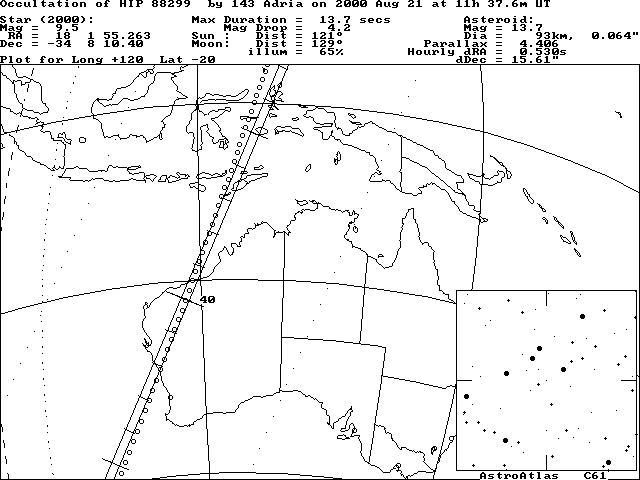THIS UPDATE REPLACES THE PREVIOUS UPDATE OF 10 AUGUST.
CHECK THIS PAGE REGULARLY FOR FURTHER UPDATES AND CHANGES TO THE TRACK.
YOU MUST RELOAD THIS PAGE USING YOUR BROWSER'S
RELOAD/REFRESH BUTTON TO OBTAIN UPDATES!
This prediction update has been computed by Jan Manek of the Stefanik Observatory based on astrometry from Ron Stone of the US Naval Observatory - Flagstaff Station. The Hipparcos position of the target star has been used.
Summary:
This update indicates a shift in the predicted path to the north-west of around 0.2" or 2 path widths and around 0.3 of a minute later than as predicted by Edwin Goffin. The path now crosses the Western Australian coastline just to the south of Geraldton (11:38 UT) running towards the north-east. The path runs just to the east of Paraburdoo and Tom Price and emerges across the coastline again to the east of Port Hedland (11:40:40 UT). The path then crosses the eastern parts of Indonesia and crosses western Japan at low altitude (11:52 UT).
When consulting the map below, observers are urged to note that the circles near the ruled path are the actual path centreline - not the time graduated lines. !! Since the asteroid has been at very southerly declinations for most of this year, recent observations from Flagstaff, Arizona have been made at low altitudes. This has resulted in larger than usual uncertainties in the observations and consequently this updated path. With an uncertainty of around 2.2 path widths, Perth lies on or very close to the edge of the error band with a predicted time of 11:37 UT. Exmouth lies just to the west of the error band with a predicted time of 11:39:30 UT. THE EVENT AT ONE GLIMPSE:To see a detailed finder chart, click here.

IMPORTANT NOTE!
Astrometric updates such as these should not be taken as definitive, but rather only as an indication of where the true track may lie relative to the original predicted track. Observers must bear in mind that later astrometry, in which the target star is measured in the same field as the asteroid, may still reveal substantial changes to the predicted track and time of the event. For this reason it is most important that observers far from the predicted track still monitor the event.
Use these links for further information:
[Planetary Occultations]
[Using the Predictions]
[Observing Details]
[Timing Details]
[Reporting Details]
[Report Form]
[Asteroid Occultation Results]
[Top of Page][Return to Home Page]